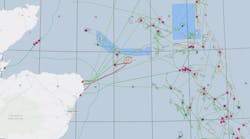WASHINGTON, DC, Jan. 24 -- US Sec. of the Interior Gale Norton Wednesday said the department remains committed to using royalty-in-kind as a way to manage federal lease revenues even after a program to fill the Strategic Petroleum Reserve with offshore royalty oil is complete.
"It makes sense to continue to expand RIK," Norton said in a brief interview following a speech she made at the Minerals Management Service's 20th year anniversary celebration. "And SPR is one part of that."
MMS last week began soliciting written bids from prequalified companies to fill the Strategic Petroleum Reserve with federal royalty oil from the Gulf of Mexico (OGJ Online, Jan. 22, 2002). Instead of buying oil on the world market, US officials plan to collect 22 million bbl between this April and March 2003 by dramatically expanding MMS' royalty-in-kind pilot program. Ultimately about 100 million bbl of royalty oil may be added to the SPR over the next few years, US officials said. The Department of Energy is working with MMS on the oil transfers.
President George W. Bush announced the program last November. MMS currently takes royalties of 100,000 b/d oil "in kind," rather than in cash under a pilot program. About half of that is sold to small refiners.
Ultimately, DOE and MMS hope to increase the royalty-in-kind transfer volumes later this year. Should this occur, both agencies would issue further sets of coordinated solicitations for the additional production, DOE said. The agencies also anticipate future solicitations next year and beyond.
After the SPR is filled to its 700 million bbl capacity, Norton said she still expects to see MMS use RIK for both onshore and offshore leases.
"We'll continue after that [SPR] is done, and I anticipate we'll be heading for more onshore leases," she said. But the department has not decided whether it would use RIK for all federal leases instead of the traditional cash system that is now based on oil market indexes.
Industry would like to see RIK expanded across the board for all federal leases, but the Interior Department has so far resisted legislative proposals that would mandate RIK.
Some state governments share Interior's reluctance to use RIK exclusively.
A 1998 study by the General Accounting Office found that RIK might not be a cost-effective option when leases are in thinly traded market centers.
MMS administers the US government's largest source of nontax revenue. Last year the agency collected $6.5 billion in revenue from offshore oil and gas leases; onshore revenue was $2.1 billion. About $1 billion is earmarked for land and water conservation programs.




